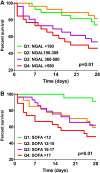Serum neutrophil gelatinase-associated lipocalin at inception of renal replacement therapy predicts survival in critically ill patients with acute kidney injury
- PMID: 20122150
- PMCID: PMC2875521
- DOI: 10.1186/cc8861
Serum neutrophil gelatinase-associated lipocalin at inception of renal replacement therapy predicts survival in critically ill patients with acute kidney injury
Abstract
Introduction: Neutrophil gelatinase-associated lipocalin (NGAL) is a promising novel biomarker that correlates with the severity and outcome of acute kidney injury (AKI). However, its prognostic utility during the late course of AKI, especially in patients that require renal replacement therapy (RRT) remains unknown. The aim of this study was to evaluate the predictive value of serum NGAL in patients with established AKI at inception of RRT in the intensive care unit (ICU).
Methods: Serum NGAL (ELISA methodology) was measured in 109 critically ill patients with AKI at inception of RRT in 7 ICUs of a tertiary care university hospital. The primary outcome studied was 28-day mortality. Secondary outcome measures were ICU length of stay, ventilator-free days, and renal recovery at day 28.
Results: There was a significant difference in serum NGAL between healthy subjects (median [interquartile range] 39.0 [37.5-42.75] ng/mL), critically ill patients with systemic inflammatory response syndrome (SIRS) (297 [184-490] ng/mL), and critically ill patients with sepsis (708 [365-1301] ng/mL; P < 0.0001), respectively. Multiple linear regression showed that NGAL levels were independently related to the severity of AKI and the extent of systemic inflammation. NGAL levels were higher in non-survivors (430 [303-942] ng/mL) compared to survivors (298 [159-506] ng/mL; P = 0.004). Consistently, Cox proportional hazards regression analysis identified NGAL as a strong independent predictor for 28-day survival (hazard ratio 1.6 (95% confidence interval [CI] 1.15 - 2.23), P = 0.005).
Conclusions: This is the first prospective evaluation of serum NGAL as an outcome-specific biomarker in critically ill patients at initiation of RRT. The results from this study indicate that serum NGAL is as an independent predictor of 28-day mortality in ICU patients with dialysis-dependent AKI.
Figures



References
-
- Brivet FG, Kleinknecht DJ, Loirat P, Landais PJ. Acute renal failure in intensive care units--causes, outcome, and prognostic factors of hospital mortality; a prospective, multicenter study. French Study Group on Acute Renal Failure. Crit Care Med. 1996;24:192–198. doi: 10.1097/00003246-199602000-00003. - DOI - PubMed
-
- Oppert M, Engel C, Brunkhorst FM, Bogatsch H, Reinhart K, Frei U, Eckardt KU, Loeffler M, John S. Acute renal failure in patients with severe sepsis and septic shock--a significant independent risk factor for mortality: results from the German Prevalence Study. Nephrol Dial Transplant. 2008;23:904–909. doi: 10.1093/ndt/gfm610. - DOI - PubMed
-
- Palevsky PM, Zhang JH, O'Connor TZ, Chertow GM, Crowley ST, Choudhury D, Finkel K, Kellum JA, Paganini E, Schein RM, Smith MW, Swanson KM, Thompson BT, Vijayan A, Watnick S, Star RA, Peduzzi P. Intensity of renal support in critically ill patients with acute kidney injury. N Engl J Med. 2008;359:7–20. doi: 10.1056/NEJMoa0802639. - DOI - PMC - PubMed
Publication types
MeSH terms
Substances
LinkOut - more resources
Full Text Sources
Medical
Miscellaneous

